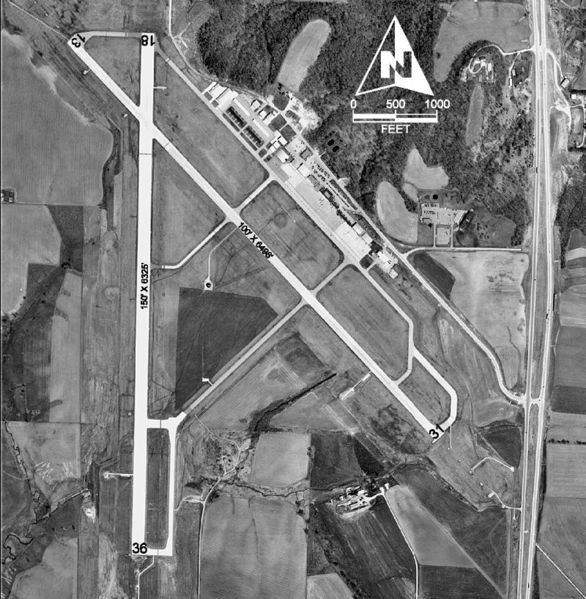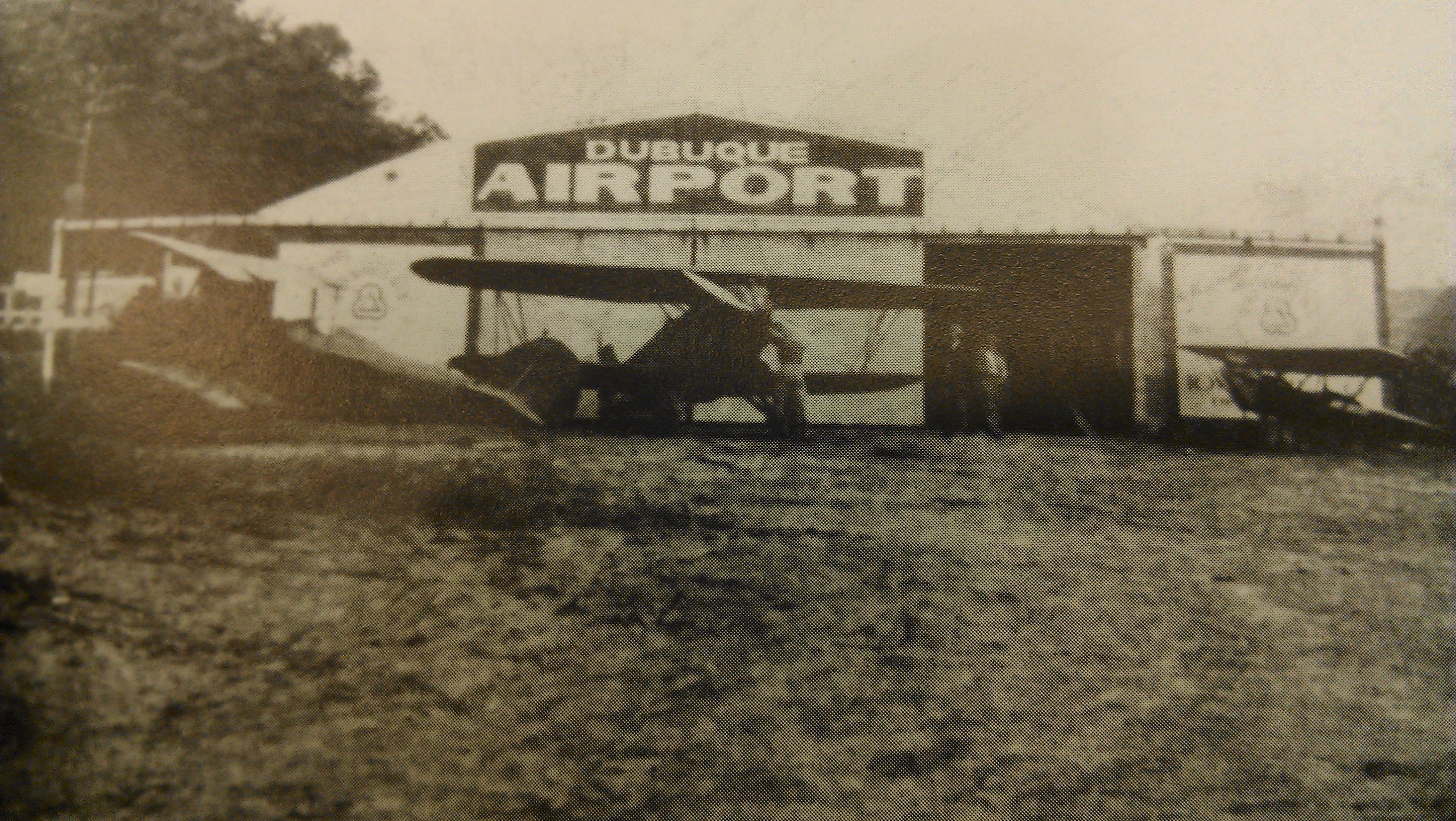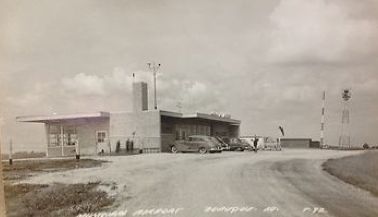Encyclopedia Dubuque
"Encyclopedia Dubuque is the online authority for all things Dubuque, written by the people who know the city best.”
Marshall Cohen—researcher and producer, CNN
Affiliated with the Local History Network of the State Historical Society of Iowa, and the Iowa Museum Association.
AIRPORT: Difference between revisions
No edit summary |
No edit summary |
||
| Line 3: | Line 3: | ||
Dubuque first airport, established by McBoyle's company, opened that year at [[NUTWOOD PARK]] on land the city leased from [[INTERSTATE POWER COMPANY]]. The site proved useful and entertaining with flying demonstrations by daredevils like [[BEACHEY, Lincoln|Lincoln BEACHEY]]. The development of the airport was carried out with the help of William J. Mackenzie, airport specialist with the United States Department of Commerce, following in inspection of the site and a review of the vicinity. He made recommendations of a different location when air transportation made a change necessary. (3) | Dubuque first airport, established by McBoyle's company, opened that year at [[NUTWOOD PARK]] on land the city leased from [[INTERSTATE POWER COMPANY]]. The site proved useful and entertaining with flying demonstrations by daredevils like [[BEACHEY, Lincoln|Lincoln BEACHEY]]. The development of the airport was carried out with the help of William J. Mackenzie, airport specialist with the United States Department of Commerce, following in inspection of the site and a review of the vicinity. He made recommendations of a different location when air transportation made a change necessary. (3) | ||
The field, leased for five years to William McBoyle, was avoided by pilots who generally found no service and the grounds not mowed. Snow posed special problems. Planes not equipped with landing | The field, leased for five years to William McBoyle, was avoided by pilots who generally found no service and the grounds not mowed. Snow posed special problems. Planes not equipped with landing skis were often signaled not to attempt to land. (4) The lease with three years to run was surrendered to the Chamber of Commerce who paid a financial settlement. (5) | ||
The second lease was awarded to the twelve young enthusiasts of [[DUBUQUE AIRWAYS INC.]] (6) Concerned about the condition of the field, the men hired Dewitt Collins as manager, instructor and pilot. The twelve businessmen purchased Collins' two-passenger, open cockpit Waco 90 before purchasing a four passenger Stinson Detroiter, known as "Miss Dubuque," for charter. A glider club was also planned. (7) | The second lease was awarded to the twelve young enthusiasts of [[DUBUQUE AIRWAYS INC.]] (6) Concerned about the condition of the field, the men hired Dewitt Collins as manager, instructor and pilot. The twelve businessmen purchased Collins' two-passenger, open cockpit Waco 90 before purchasing a four passenger Stinson Detroiter, known as "Miss Dubuque," for charter. A glider club was also planned. (7) | ||
Revision as of 20:27, 7 October 2013
AIRPORT. In 1928 articles of incorporation were filed with the Iowa Secretary of State for the Iowa Airport Company Inc. The president was William McBoyle. The articles detailed plans of the company headquartered in Dubuque to engage in establishing "flying fields," the buying and selling of airplanes, the transportation of passengers, and in aerial photography and advertising. In May, 1928 work on Dubuque's first municipal airport, located north of the city along Sageville Road, was announced as nearly finished. (1) Swamp land at the south end of the field had to be filled and high lines to the north had to be removed. Parking space was being provided to "allow autoists to view antics of the machines from their machines." (2)
Dubuque first airport, established by McBoyle's company, opened that year at NUTWOOD PARK on land the city leased from INTERSTATE POWER COMPANY. The site proved useful and entertaining with flying demonstrations by daredevils like Lincoln BEACHEY. The development of the airport was carried out with the help of William J. Mackenzie, airport specialist with the United States Department of Commerce, following in inspection of the site and a review of the vicinity. He made recommendations of a different location when air transportation made a change necessary. (3)
The field, leased for five years to William McBoyle, was avoided by pilots who generally found no service and the grounds not mowed. Snow posed special problems. Planes not equipped with landing skis were often signaled not to attempt to land. (4) The lease with three years to run was surrendered to the Chamber of Commerce who paid a financial settlement. (5)
The second lease was awarded to the twelve young enthusiasts of DUBUQUE AIRWAYS INC. (6) Concerned about the condition of the field, the men hired Dewitt Collins as manager, instructor and pilot. The twelve businessmen purchased Collins' two-passenger, open cockpit Waco 90 before purchasing a four passenger Stinson Detroiter, known as "Miss Dubuque," for charter. A glider club was also planned. (7)
Nutwood Park proved a poor location for an airport. Surrounded on the east and west by hills, all landings had to be attempted from the north or south regardless of wind. High-tension telephone lines on the north and a swamp and tall smokestack on the south increased the danger. The facility had one runway, a 1,320-foot sod strip.
In 1933 the Dubuque City Council purchased 162 wild and woody acres of CITY ISLAND for $10,000. Unemployed men, recruited by the Civil Works Administration during the Great Depression, leveled trees, ripped out stumps and slashed away underbrush. After extensive grading, two runways, each 2,600 feet long and 100 feet wide, were constructed of MACADAM and cinder surface. The new airport was reached by a road linking the site to the foot of East 16th Street.
Operations at the City Island airport began in June 1934, when two Dubuque Airways planes were flown to the site from Nutwood Park. With no hangars or gas tanks, planes had to be tied down at night. Nutwood Park's metal hangar was later dismantled and rebuilt at the new site; a new hangar with an office was constructed within one year. Electricity was supplied by a portable gas-powered generator. There were "His" and "Her" outhouses.
Business at the City Island airport was not brisk. Lewis Boxleiter, Collins' successor as airport manager, applied for a low-flying permit and inspected high transmission lines when foul weather prevented linemen from driving over snow-drifted roads. Each spring because of floods the planes had to be flown to high ground in Waterloo, Iowa, or Galena, Illinois. In 1938 sixty-four days of business at the City Island airport were lost due to flooding. The airport flooded from March 31 until April 17 in 1939. It was submerged again on April 28.
In 1939 Dubuque was visited by T.E. Flaherty, acting regional airport engineer for the Civil Aeronautics Administration. A solution to the flooding of the airport seemed urgent since Dubuque seemed likely be placed on an airmail and passenger route. Petitions for a Chicago (Illinois)-Cheyenne (Wyoming) route through Dubuque, Mason City and Sioux City had been filed with the Interstate Commerce Commission. He told city officials that other cities were quickly constructing suitable sites for airports realizing that being left off a route could doom a city's development. A $100 million appropriations bill to help cities construct airports was to be introduced in Congress. (8)
Flying around the Dubuque area in an airplane owned by the Telegraph Herald, Flaherty stated that the elimination of obstacles to landing was essential. Long runways were needed. He recommended that the city not be concerned with building an airport ten miles from the city. Travel time, he reminded them, was cut with automobiles and was only a concern within the city limits. (9)
Flying instruction began in earnest in January 1940, with the start of the Civilian Pilots Training Program. After the start of WORLD WAR II, operations at the airport were temporarily halted and city police were assigned to guard the site. (10) A new hangar was constructed. The navy's objection to the city's inadequate airport led the Chamber of Commerce to conduct a survey as a first step in establishing a first-class airport for the city.
In February 1942, the Dubuque Airport became the first in Iowa to receive its wear emergency designation from the Civil Aeronautics Administration. This ensured that the airport would remain open but that it had have armed guards around-the-clock, a complete alarm system, and clearance officials. (11)
On November 4, 1942, Dubuque voters approved a special levy for the development of a new airport. Land was purchased south of the city in March 1943, for the planned $2.5 million facility. City manager Albin RHOMBERG, Fred W. WOODWARD of the TELEGRAPH HERALD, and Msgr. M. J. Martin, president of LORAS COLLEGE obtained a $600,000 appropriation from the Civil Aeronautics Administration for a class-4 airport after working with Senator Guy M. Gillette.
Grading, started in 1944, was completed in 1946. Construction work, which included two "T" hangars, was completed in 1948. The City Island airport was closed in September 1948. The Dubuque Municipal Airport was dedicated October 24th. On September 6, 1988, the name of the airport was changed from the Dubuque Municipal Airport to the Dubuque Regional Airport to more accurately describe the service area and aid in marketing.
The airport is owned by the city of Dubuque and operated as a department of city government. An Airport Commission board appointed by the city council oversees the airport. The airport manager is hired to run the day-to-day operations.
The Dubuque Regional Airport has received Federal Aviation Administration recognition of its commitment to safety many times. The airport received the FAA’s “Airport Safety Enhancement Award” in 1994, 1997, 2000, and 2003. In 2004 the airport recorded fourteen consecutive years of perfect safety inspections. In 2007 the City of Dubuque announced its intention to construct a larger terminal building, but no time line was given for the completion of the project.
In October, 2013 the building structure of the new Dubuque Regional Airport terminal was completed, but interior work remained. The first large capital improvement project for the airport in decades, the terminal building was only a portion of the changes planned for completion in late 2016.
The planned $39 million, 33,000 square-foot terminal would triple the space of the existing facility with a design that would allow for future expansion. Parking amenities, and airplane taxi spaces were also to be increased. (12)
---
Sources:
1. "Dubuque Airport is Incorporated," Telegraph Herald and Times Journal, May 30, 1928, p. 9. Online: http://news.google.com/newspapers?id=_apFAAAAIBAJ&sjid=Gr0MAAAAIBAJ&pg=4427,5869836&dq=dubuque+airport&hl=en
2. Advantages of the Dubuque Airport Demonstrated," Telegraph Herald and Times Journal, May 27, 1928, p. 6. Online: http://news.google.com/newspapers?id=-qpFAAAAIBAJ&sjid=Gr0MAAAAIBAJ&pg=4139,5360162&dq=dubuque+airport&hl=en
3. "Dubuque Airport Finds Defender," Telegraph Herald, June 16, 1929, p. 24. Online: http://news.google.com/newspapers?id=nXlFAAAAIBAJ&sjid=wrwMAAAAIBAJ&pg=2521,5098485&dq=dubuque+airport&hl=en
4. "Clear Snow From Dubuque Airport," Telegraph Herald and Times Journal, Feb. 19, 1929, p. 25. Online: http://news.google.com/newspapers?id=yolFAAAAIBAJ&sjid=sbwMAAAAIBAJ&pg=3650,2171206&dq=dubuque+airport&hl=en
5. "Dubuque Airport is in New Hands," Telegraph Herald and Times Journal, Jan. 3, 1930, p. 10. Online: http://news.google.com/newspapers?id=9bNFAAAAIBAJ&sjid=P70MAAAAIBAJ&pg=5428,2896206&dq=dubuque+airport&hl=en
6. Ibid.
7. Ibid.
8. Goettler, William. "Engineer Offers Tips for Dubuque Airport," Telegraph Herald, May 28, 1939, p. 2. Online: http://news.google.com/newspapers?id=XelBAAAAIBAJ&sjid=FaoMAAAAIBAJ&pg=4290,5491436&dq=dubuque+airport&hl=en
9. Ibid.
10. "Activities Resumed at Dubuque Airport," Telegraph Herald, Dec. 12, 1941, p. 2. Online: http://news.google.com/newspapers?id=hFxFAAAAIBAJ&sjid=ELwMAAAAIBAJ&pg=3395,4180865&dq=dubuque+airport&hl=en
11. "Local Airport Gets War OKED," Telegraph Herald, Feb. 17, 1942, p. 3. Online: http://news.google.com/newspapers?id=5TpFAAAAIBAJ&sjid=lLsMAAAAIBAJ&pg=4533,5476882&dq=dubuque+airport&hl=en
12. Jacobson, Ben. "Airport Project Right on Schedule," Telegraph Herald, Sept 10, 2013, p. 1





